The Correlation and Distinguishment of Vicarious Trauma in Crime Scenes and the Psychological Effects it has on Crime Scene Investigators
Anton Ferraro
ABSTRACT
 Minimal research has been done regarding Vicarious Trauma on the well-being of Crime Scene Investigators. It is well known that experiencing traumatic events has the potential to lead to mental health disorders including Post-Traumatic Stress Disorder. In this study, 28 forensic science professionals in mostly midsize metropolitan areas were surveyed about their personal experiences, lifestyle, and perception of traumatic circumstances. This mixed study used a basic rating scale assessing trauma, stress, and frequencies of experiences throughout the careers of the respondents. Three specific aims were identified in assessing whether substantial differences existed in the way Crime Scene Investigators associated trauma with different circumstances in crime scenes. The discussion examines what circumstances lead Crime Scene Investigators to associate more trauma to specific crime scenes. Further research is suggested to evaluate physiological responses to vicarious trauma in crime scenes, how coping mechanisms play a role in trauma assessment, and formal mental health disorder diagnoses in forensic science professionals.
Minimal research has been done regarding Vicarious Trauma on the well-being of Crime Scene Investigators. It is well known that experiencing traumatic events has the potential to lead to mental health disorders including Post-Traumatic Stress Disorder. In this study, 28 forensic science professionals in mostly midsize metropolitan areas were surveyed about their personal experiences, lifestyle, and perception of traumatic circumstances. This mixed study used a basic rating scale assessing trauma, stress, and frequencies of experiences throughout the careers of the respondents. Three specific aims were identified in assessing whether substantial differences existed in the way Crime Scene Investigators associated trauma with different circumstances in crime scenes. The discussion examines what circumstances lead Crime Scene Investigators to associate more trauma to specific crime scenes. Further research is suggested to evaluate physiological responses to vicarious trauma in crime scenes, how coping mechanisms play a role in trauma assessment, and formal mental health disorder diagnoses in forensic science professionals.
See also the instructional video "Traits of a Successful Crime Scene Investigator"
INTRODUCTION
There has been minimal research done on the effects of violent crime scenes on the psychological well-being of Crime Scene Investigators (CSIs). In the studies that have been done, it has been determined that often, CSIs tend to keep their trauma to themselves and not seek professional help (Clark et al., 2015). This could be due to a variety of reasons, including, but not limited to, the CSI not having a proper "toolkit" for dealing with trauma, the organization not emphasizing the importance of recognizing and dealing with trauma, or a long-standing stigma surrounding the discussion of traumatic events and the psychological impacts they have on humans. Many of these studies have used vicarious trauma (VT) as the definition for trauma experienced by CSIs (Mountain, 2021; Clark et al., 2015; Levin et al., 2021). McCann and Pearlman first defined VT as "a natural pervasive change resulting from the repeated exposure to experiences and feelings of a traumatic event experienced by another person" (McCann and Pearlman, 1990). VT can lead to symptoms of Post-Traumatic Stress Disorder (Roberts et al., 2022). Post-Traumatic Stress Disorder (PTSD) has been studied and diagnosed since 1980, with the original studies being done on veterans of war (va.gov, 2018). PTSD is diagnosed by a medical professional and studies have shown it is common among people who experience traumatic events in their lives.
Vicarious Trauma
Vicarious trauma is the scientifically accepted term for trauma that people who work in law enforcement, emergency medical services, fire services, and other professions, experience when they are exposed to victims of trauma or violent crimes (What is vicarious trauma?: The Vicarious Trauma Toolkit, n.d.). The word "vicarious" literally means "experienced or realized through imaginative or sympathetic participation in the experience of another" (Merriam-Webster, n.d.). In this research, this term will be used as the variable being measured and examined on a scene-by-scene basis to determine the effects different levels of this trauma have on a CSI.
Post-Traumatic Stress Disorder
Post-traumatic stress disorder is a psychiatric disorder in which someone who experiences or witnesses a traumatic event shows emotional or physical symptoms that negatively affect their well-being after the incident has occurred (What is posttraumatic stress disorder (PTSD), n.d.). PTSD can occur in any profession; however, it is much more common in professions that experience higher levels of trauma. Since it is a mental health disorder, it largely depends on the individual experiencing the trauma and varies in severity from person to person. About 1 in 3 people who experience a traumatic event develop PTSD, although it is unclear what causes the disorder to develop (NHS, 2022). This research strives to show, in part, if a correlation between the severity of vicarious trauma experienced and the likelihood of a CSI developing PTSD exists. A study done by Levin et al. (2021) found that death investigators experienced more symptoms of PTSD than medical examiners and child deaths were the strongest predictors of the disease. This information is key in formulating the hypotheses for what this research aims to prove. The hypothesis predicts that crime scenes containing victims who are children will be given higher VT scores by CSIs, especially those who have children of their own.
The Role of a CSI
The most basic description of what a CSI does is process a crime scene. The "processing" of a scene includes documentation, evidence collection, and using investigative techniques to attempt to discover the truth of what happened. The CSI plays a critical role in a criminal investigation. It is not disputed that the job of a CSI is considered stressful. In a study done by Almazrouei et al. (2021), CSIs reported more stress due to their cases than analytical examiners did. The added stress CSIs may experience compared to their law enforcement officer counterparts could be due to their extended exposure (time spent) at a crime scene (Leone & Keel, 2016). By being exposed to specific types of crime scenes for extended periods, the hypothesis that CSIs will experience more vicarious trauma at more complex crime scenes is supported. Results from the study done by Leone & Keel (2016) also support the hypotheses that crime scenes involving victims that resemble known persons of CSIs, crime scenes with a high number of deceased victims (mass fatalities), and crime scenes involving child victims will create the most vicarious trauma for CSIs.
Stigmas
There is an issue with mental health disorders that has grown to become a focal point of many recent research studies. This issue is the stigma associated with mental health. "Stigma, prejudice, and discrimination against people with mental illness is still very much a problem" (Borenstein, 2020). Due to this, many people who experience trauma, or a mental disorder do not seek help. There has been a long-standing stigma, especially in men, that people should be "tough" and "get through it", and therefore historically did not report mental health issues they may have had. Men also tend to think that minor traumatic events do not affect them in a significant way, and they can "push aside" the trauma of an event and not be impacted. "The expectation that we can be immersed in suffering and loss daily and not be touched by it is as unrealistic as expecting to be able to walk through water without getting wet" (Remen, 2006). Respondents in prior studies have reported intentionally avoiding professional help due to fear of being "labeled" mentally ill (Mittal et al., 2013). This is an issue that needs to be addressed to create a better career and life for CSIs and anyone else who is impacted by trauma. Although the research on stigmas and the correlation of perceptions to levels of trauma and PTSD is not the focus of this study, the results may indicate whether these stigmas played a factor in the CSIs utilization of resources available to aid in psychological healing.
OBJECTIVES
This study will aim to collect data and draw conclusions on the three hypotheses identified below:
- In crime scenes that involve a higher number of deceased victims, a child victim, or a victim that the CSI has a personal connection to, the CSI will associate higher VT to the scene than a scene not containing one of these conditions.
- CSIs that experience a higher volume of gruesome crime scenes will associate a lower VT to each type of crime scene but will experience more symptoms of PTSD overall than CSIs who investigate a lesser volume of gruesome crime scenes.
- CSIs who utilize healthy coping mechanisms and have strong organizational support systems will associate a lower VT to each type of crime scene than CSIs who do not utilize healthy coping mechanisms.
This hypothesis aims to show that crime scenes containing certain conditions are viewed as more traumatic for investigators than crime scenes without those conditions. Prior work has been done, specifically related to stress correlated with some of the scenes containing these aspects (Leone & Keel, 2016), however vicarious trauma in crime scenes with specific elements has not been previously studied. To test this hypothesis, specific questions will be asked regarding the types of crime scenes investigated, and the term "personal connection" will be defined. The data will be collected, and results will be analyzed to determine what correlation, if any, these conditions of the crime scene have to the trauma associated with the scene according to CSIs.
This hypothesis is formed based on the concept of desensitization. Desensitization, simply, is when somebody reacts less to a stimulus after being exposed to that same stimulus over time. There have been several studies done about desensitization and the effects it has on individuals (Denk-Florea et al., 2020; Warren, 2015). For this hypothesis, the term "gruesome" will need to be defined and contextualized within crime scenes. A potential risk to the quantity of data collected supporting this hypothesis includes a low number of CSIs witnessing a "high volume" of gruesome crime scenes. Additionally, CSIs may hesitate to report symptoms of PTSD, or they may not be fully aware of the subconscious or physiological symptoms of PTSD that they experience. This could result in a low population sample size which may result in data that is statistically irrelevant.
This hypothesis is formed on the basis that CSIs either utilize "healthy, unhealthy, or neutral" coping mechanisms for trauma. Coping mechanisms will be defined and classified, and responses will be grouped into one of these categories. Studies have been conducted related to coping mechanisms in the forensic science and law enforcement communities, and a literature review by Slack (2020) called for future studies about VT to be conducted with a specialized focus on forensic service professionals to help organizations adapt to better support these roles. The data collected to support or refute this hypothesis will enable organizations to adapt their mental health support systems to better support CSIs and their ability to handle trauma at crime scenes.
Purpose
This study is being conducted to promote better overall well-being for Crime Scene Investigators. By understanding the traumatic impacts of Vicarious Trauma, CSIs can be better equipped to deal with and overcome trauma in their lives. This should lead to higher job satisfaction, increased productivity at work, and hopefully increased overall health in their personal lives as well. This study hopes to exploit the link between VT and symptoms of PTSD if it exists. Specifically, it may help to show what specific circumstances at crime scenes could lead to higher trauma in CSIs so that agencies can be better prepared to help their investigators deal with that trauma. By linking specific occurrences to the frequency of PTSD symptoms that are experienced, the forensic science community can better prepare to deal with these impacts to promote well-being in a preventative manner.
Another specific aim of this research is to attempt to correlate coping mechanisms used with symptoms of PTSD experienced. By analyzing coping mechanisms utilized, this study should be able to promote the most effective ways to deal with VT for CSIs. The hypothesis in this study is that healthy coping mechanisms will yield fewer symptoms of PTSD than unhealthy coping mechanisms. Healthy coping mechanisms include exercise, therapy, sports, and socializing with friends. Unhealthy coping mechanisms include alcohol and or drug abuse, avoidance/compartmentalizing, and isolation. One study found that seeking social support helped to prevent PTSD (Ozer et al., 2003). If the data supports the hypothesis, this research can be used by law enforcement agencies to emphasize the importance of utilizing healthy coping mechanisms for their CSIs and possibly provide resources to help them do that, as it would likely lead to more productive work. To collect the data, a mixed-method approach consisting of a survey will be distributed to CSIs. Once the surveys are returned, the insights provided by the respondents will show either support or refute the hypothesis, and the results will be analyzed and discussed.
One final impact this research aims to make is to promote and summarize future research needed around the topic. The forensic science community must continue to foster a healthy working environment for those in the field to achieve the greatest results. If forensic scientists become victims of burnout, traumatic disorders, or job resentment, they will not be able to perform at their best, and ultimately their work quality will suffer. This should be viewed as a risk to the forensic science community, and further research on topics such as this will aid in the prevention and mitigation of those risks. By highlighting what future research should be completed, this study will help pave a path forward for improving the Crime Scene Investigator's output and their quality of life both at work and at home.
METHODS
This study consisted of a mixed (qualitative and quantitative) survey that was circulated to law enforcement agencies in Colorado. A total of 15 agencies were selected for survey circulation. Additionally, two individuals who were known by the researcher through work experience and are now retired were sent the survey as well. Several factors impacted which agencies were selected, however, the main factors are listed below:
- Availability of contact information for department leaders
- Number of potential respondents estimated at each agency
- Geographic location in relation to densely populated areas in Colorado
- Potential exposure to a high volume of crime, specifically violent crime
The survey was disseminated to leaders and directors of crime labs and supervisors of crime scene investigators at each agency. The survey was assembled on SurveyMonkey, a leading platform in electronic surveys. A link to the survey was included in an email sent to the point of contact identified at each department. The contact information for each department was obtained through a combination of efforts including phone calls, emails, and personal connections. The survey consisted of 58 questions with a single open-ended optional response question at the end of the survey. The survey contained demographic questions, questions related to the personal experiences of the respondents, and questions assessing the traumatic impacts of hypothetical scenarios for the respondents. The questions were carefully selected by the researcher to collect data related to the hypotheses identified. The response options for each question were based on the type of question being asked. Some questions about personal agreement with statements were rated on a scale of "disagree" to "agree." To evaluate trauma related to specific situations, a scale was used for the respondents to rate their perceived trauma from 1 to 10. Other questions related to personal habits or statements about the investigator's personal life contained qualitative response options, specifically related to the frequency of events or feelings they may experience. The individual responses to the surveys were anonymous and confidential, and for this report, the departments that were contacted will remain anonymous. The survey response window was open from Friday, March 29th to Friday, April 19th. The cover letter for the study as well as the complete survey is attached in APPENDIX I.
RESULTS
Twenty-eight responses were collected in the time the survey window was open. This results section will provide a breakdown of the demographic information of the respondents, their overall experiences in crime scene investigation, and results related to trauma that they associated with hypothetical scenarios. The results section will summarize the data collected relevant to the hypotheses.
Demographic Information
Of the 28 respondents, 39.29% were between the ages of 30-39 (N=11). This represented the largest population of an age group in the survey. The age range with the least number of respondents was 20-29 (N=3). There were 24 females and 4 males who responded to the survey. Most respondents were married (N=18) and had children (N=17). Most respondents (92.86%) identified as White, and 85.71% were not of Hispanic / Latino ethnicity.
General Career Information
Most of the respondents have been in the Crime Scene Investigation field for over 5 years (N=19). Fourteen respondents have been in the field for at least 10 years. Additionally, most respondents have been with the same law enforcement organization for over 5 years (N=18). There were 25 civilians and 3 officers who responded. Question 10 asked the respondents to classify their department by the type of area they served. The responses are displayed in Table 1.
Table 1
Responses to Question 10: How would you classify your law enforcement organization?
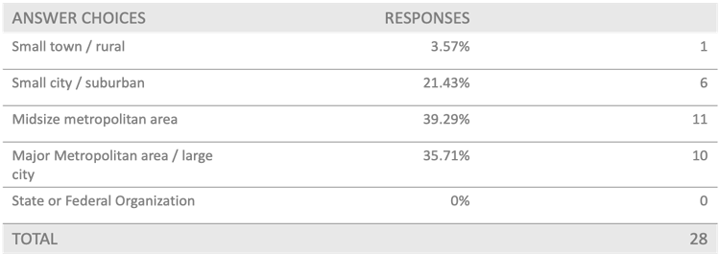
Exposure to Specific Types of Crime Scenes
Of the 28 respondents, 25 indicated they had processed a homicide scene, and the same number indicated they had processed a suicide and a sexual assault scene. The experience levels of the CSIs varied, with 10 respondents (35.71%) reporting processing over 1000 total crime scenes in their career. Only 3 respondents reported processing 50 or fewer total crime scenes in their career. Table 2 shows the number of homicide scenes the respondents reported having attended in their careers. Of these homicide scenes attended, 13 respondents had attended 1-5 scenes that included at least 5 deceased victims. Thirteen respondents reported never attending a homicide scene that included at least 5 deceased victims. Two respondents had attended a scene that included at least 10 deceased victims. The respondents include a mix of investigators who have been exposed to crime scenes with varying numbers of deceased individuals. This data aligns with the hypothesis and will provide context for the conclusions drawn in the discussion section.
Nine respondents had processed a crime scene that included a victim they knew in their career. Fifteen respondents had processed a scene with a victim that they felt a personal connection to. This split again provides a mix of experiences among the respondents related to the hypothesis of trauma associated with victims the investigator knows, and this will be discussed in the discussion section as well.
Table 2
Responses to Question 15: How many homicide scenes have you attended in your career?
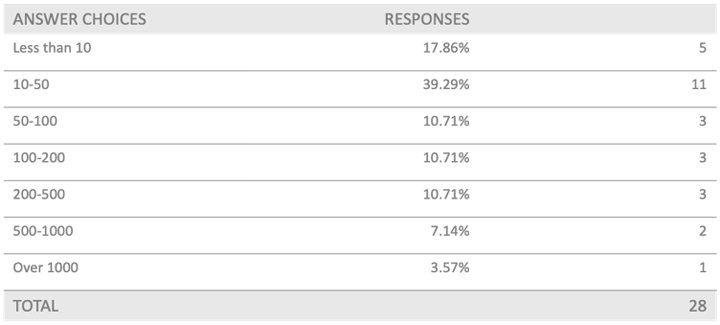
Exposure to Gruesome Crime Scenes
Questions 23 and 24 of this survey were related to the respondent's interpretation of their exposure to gruesome crime scenes. Question 23 asked "Have you ever processed a crime scene that included particularly gruesome aspects? (i.e. large amounts of blood and gore, dismemberment, mutilation, etc.)." Twenty-five of the respondents answered "YES" to this question. The next question was to quantify how many of these "gruesome" crime scenes the investigators have processed. The results are shown in Table 3.
Table 3
Responses to Question 24: How many gruesome crime scenes would you say you've processed in your career?
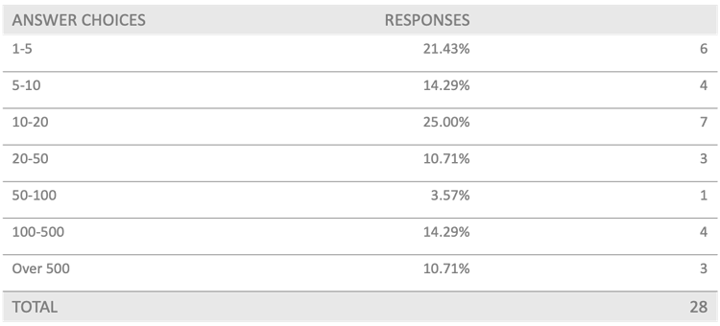
It is understood that the investigator's perception of gruesome crime scenes will vary person-to-person. This will be discussed further in the discussion section of the paper.
Job Satisfaction, Stressors, and Overall Health
Many of the respondents rated their job satisfaction highly. On a scale from 1 to 10, with 1 being "not satisfied" and 10 being "extremely satisfied", the average rating from the respondents was 8.21 (SD = 1.73). The respondents reported a low level of feeling "sad, depressed, or down" (M=3.5, SD = 1.50). When asked about their health, the participants rated their overall health as 7.68/10 on average (SD = 1.06). They also rated their quality of sleep overall as 6.5/10 (SD=2.35).
Organizational Resources
The respondents rated their organization's availability of resources for dealing with trauma as 7.93/10 on average (SD=2.65). They also rated their organization's willingness to listen to feedback and make changes for the better as a 6.0/10 on average (SD = 2.65). When asked to rate their level of agreement on a scale from 1 to 10, 13 participants answered "10" to the statement "If I had any issues at work I would feel comfortable speaking to my supervisor about it." The average agreement rating for that question among the participants was 7.93/10 (SD = 2.87). Similarly, the average was 6.14/10 when evaluating the statement "If my organization dedicated more resources to my well-being I would be more satisfied in my job."
Coping Mechanisms
There were seven questions in the survey pertaining to coping mechanisms. Healthy coping mechanisms included exercise, socializing with friends, meditation/yoga, and therapy. Unhealthy coping mechanisms inquired about included alcohol usage and keeping traumatic experiences to oneself. When asked "How often do you work out or exercise?", most participants (N=19) said 3-4 times per week or more. The participants also socialize often with friends, with 24 participants stating they socialize with friends "a few times a month" or more. Therapy, although required by most Law Enforcement organizations, is not something many respondents utilize. Twenty-three respondents (82.14%) stated they go to therapy or speak to a professional about work experiences "a few times a year" or less. Tables 4 and 5 below show the two questions related to the negative coping mechanisms, and responses were varied for each question.
Table 4
Responses to Question 45: How often do you use alcohol?

Table 5
Responses to Question 48: I prefer to keep traumatic experiences to myself and not talk about them with others

One final coping mechanism utilized by many of the respondents is disassociating personal aspects of the job. Not only is this an important coping mechanism that can be correlated to how much trauma is associated with each scene, but it also factors into the hypothesis of desensitization. The statement read "I tend to disassociate the personal aspects of my job and focus on the task at hand when working." When asked to rate their level of agreement on a scale from 1 to 10, the average rating was 8.89/10 (SD = 1.29).
PTSD Symptoms
There were several questions asked related to symptoms of PTSD in the survey to gauge how many participants experienced symptoms of the disease. Questions were asked about how often flashbacks occur, how often dreams about work occur, how often the participants think about aspects of work while at home, and feelings of being alone or isolated.
When questioned how often the respondents thought about aspects of work while at home / off-duty, the average rating on a scale from 1 to 10 was 5.82/10 (SD = 2.13). Dreaming about events that occurred at work was not frequent, with the average frequency among the participants being 2.68/10 (SD = 1.66). They also reported a low level of feeling "alone or isolated" (M=2.82, SD = 1.49). The responses regarding flashbacks are displayed below in Table 6.
Table 6
Responses to Question 40: How often do you experience flashbacks or memories from prior crime scenes worked?

Scene-Specific Trauma
Eight survey questions contained hypothetical situations and asked participants to rate their perceived level of trauma associated with processing each crime scene. One general survey question asked before these 8 hypothetical situations was "How much trauma do you associate with a crime scene where the victim is a child?" Overall, the respondents rated this level of trauma a 5.65/10 on average (SD = 2.57). The breakdown of the responses to this question by respondents based on whether they have children of their own is shown in Table 7.
Table 7
Responses to Question 43: How much trauma do you associate with a crime scene where the victim is a child?"
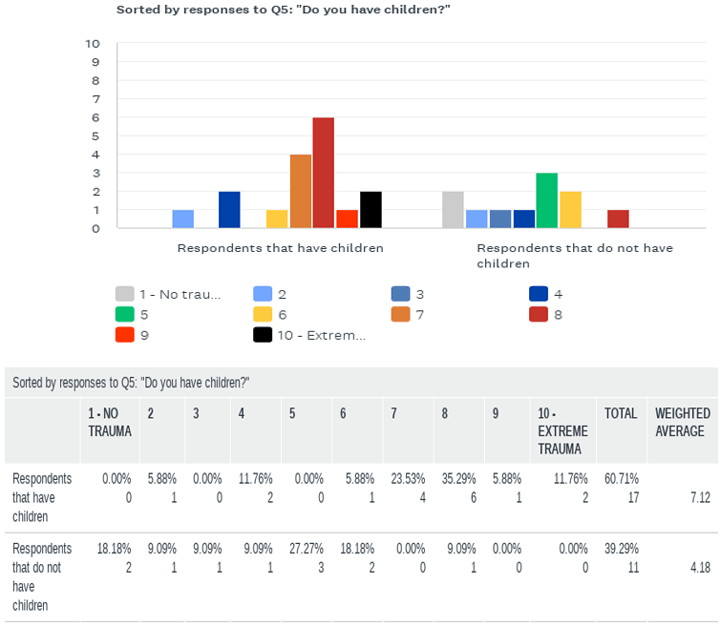
The other 8 questions related to scene-specific trauma gave more detailed hypothetical scenarios for the respondents to assess. This results section will present the results of the key scenarios related to the three hypotheses being studied. Tables 8 through 12 show the results of the most relevant scenarios related to the hypotheses being studied.
Table 8
Responses to Question 50: You are called to a homicide scene and upon arrival discover that your friend is the victim
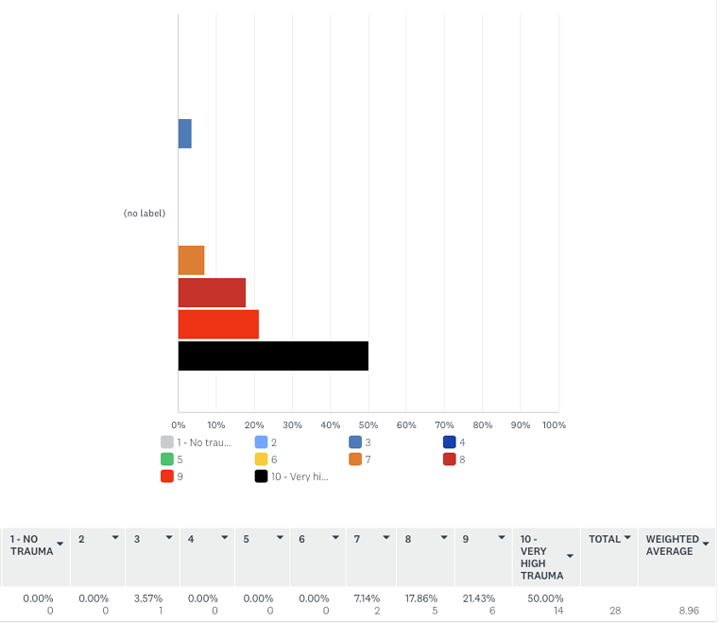
Table 9
Responses to Question 51: You are called to a suicide scene and discover a 10 year old boy hanging in a bedroom
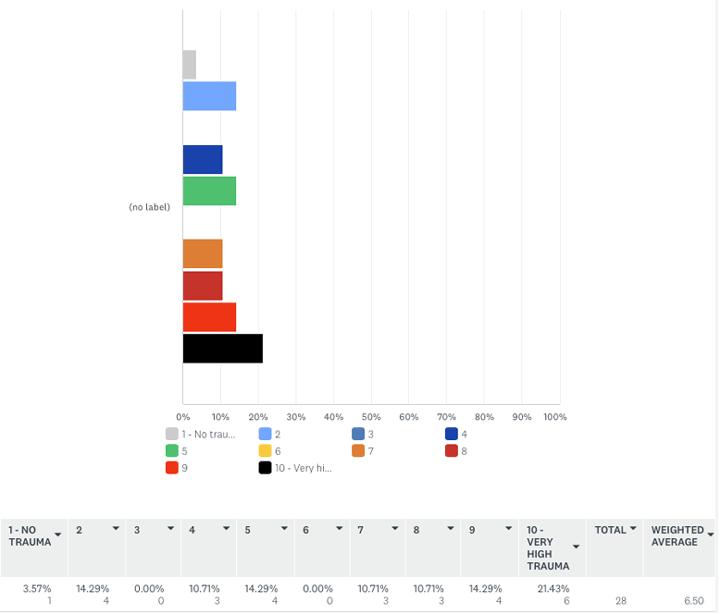
Table 10
Responses to Question 52: You are called to the scene of a shooting and upon arrival discover that there are 27 deceased individuals
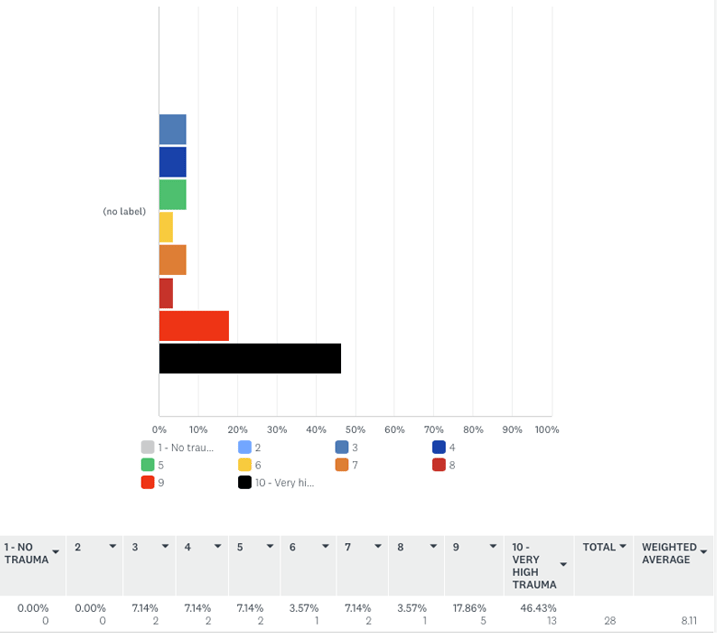
Table 11
Responses to Question 54: You are called to process a scene of a gas line explosion that killed 11 people in a factory
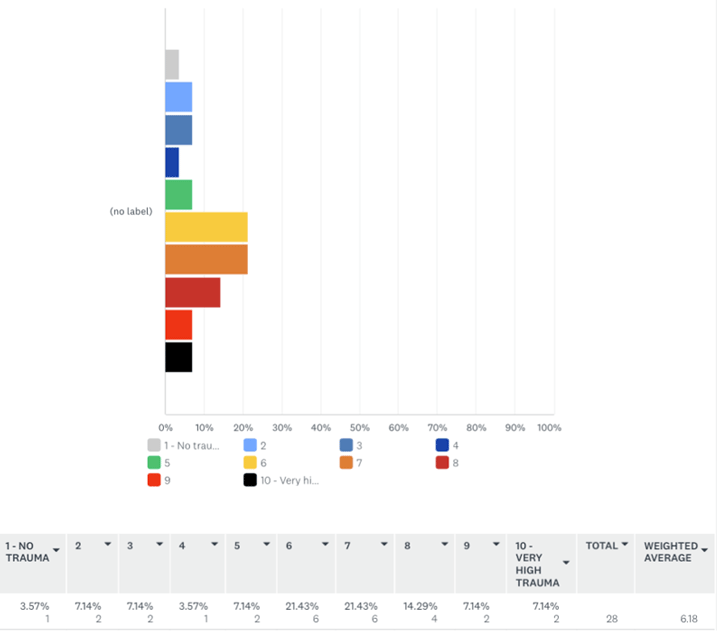
Table 12
Responses to Question 55: You are called to process a scene of a homicide where the victim reminds you of a family member
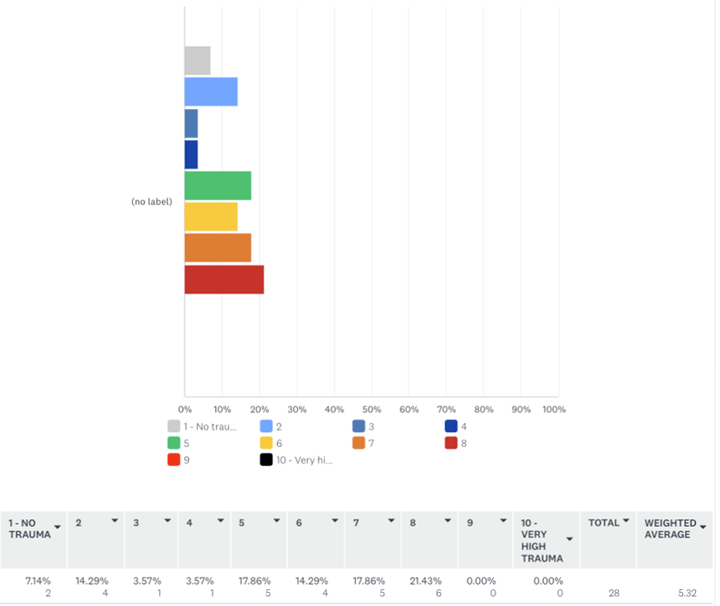
Table 13
Summary of responses from questions 50-57 and scenarios ranked by traumatic impact

Exposure to Gruesome Crime Scenes and Scene-Specific Trauma
Table 14
Trauma associated with scenarios sorted by exposure to gruesome crime scenes

Table 15
PTSD Symptom frequency and overall job stressor rating sorted by exposure to gruesome crime scenes

Coping Mechanisms and Scene-Specific Trauma
The coping mechanisms being studied involved questions regarding the frequency of use of each coping mechanism. The coping mechanisms asked about included therapy utilization, exercise, socializing with friends, meditation, yoga, & breathing exercises, and alcohol use. Tables 16 through 20 below show the correlation of how respondents who utilized these coping mechanisms evaluated the traumatic aspects of the hypothetical scenarios from questions 50-57.
Table 16
Trauma associated with scenarios sorted by frequency therapy is utilized

Table 17
Trauma associated with scenarios sorted by exercise frequency

Table 18
Trauma associated with scenarios sorted by frequency of socializing with friends

Table 19
Trauma associated with scenarios sorted by frequency of meditation & mindfulness exercises

Table 20
Trauma associated with scenarios sorted by frequency of alcohol use

Open-Ended Responses
The final survey question asked "We are interested in how work-related traumatic events impact your life. Is there anything else you'd like to add?" Below are some notable quotations from some of the respondents:
"I think instead of using trauma I would use the word stress. As an experienced CSI I feel stress the more people are hurt or killed because I want to go above and beyond to process a scene very well. I have learned early on to compartmentalize a scene so that I can focus on processing a scene well for the victims." -Respondent 23 "Its extremely beneficial to be able to talk to someone who better understands your field or even has experienced it with you. As well as having a supportive family and friends of your career" -Respondent 11
"I sometimes feel isolated from friends and family who do not have an understanding of the emotional toll my jab takes on me." -Respondent 6
"The accumulative aspect of trauma in this field of work needs to be kept in mind. The exposure to death in its varieties has changed my perception of life." -Respondent 22
DISCUSSION
The survey results provide valuable insights into the hypotheses and will be used to guide future research on a variety of topics. The discussion section of this paper will first discuss overall and general findings. Then, each hypothesis will be examined, and conclusions will be drawn. The limitations of this research will then be discussed, followed by future implications, and further suggested research.
General Observations
Overall, most of the respondents were women (24/28). Specifically, the largest demographic was white women between the ages of 30-39. Ten respondents fell into this demographic category. There were 17 of the 29 (58.6%) participants who identified as white women between the ages of 20-49. This may indicate that crime scene investigation is predominantly comprised of white women. This aligns with previous research that concludes forensic science, in general, is a predominantly female-dominated occupation and is one of the few areas of Science, Technology, Engineering, and Math (STEM) where this is the case (Barbaro, 2019). Further studies on CSIs may validate further that Crime Scene Investigation is a female-dominated occupation. Although not analyzed in this study, the ability of females to deal with trauma compared to their male counterparts in the same situations may be something of interest to researchers studying this topic in the future, since it appears more females work in this occupation than males.
Career Experience
The respondents had a wide range of experiences in their careers. Fourteen of the 28 respondents had been in the Crime Scene Investigation field for at least 10 years. This indicates that CSIs are satisfied with their careers, which aligns with the job satisfaction responses (average rating 8.21/10). Additionally, the results show that 64.29% of respondents have been with the same law enforcement organization for over 5 years. Strong organizational support and high job satisfaction may contribute to low attrition in the Crime Scene Investigation field. Previous studies have concluded that although occupational stress is high, job satisfaction among forensic scientists is also high (Holt et al., 2016). The results of this study align with that conclusion and suggest that forensic science, specifically Crime Scene Investigation, is a job of high stress, but also high job satisfaction.
Most of the respondents worked in midsize to large metropolitan areas. This was designed by the researcher when selecting which departments to survey. The reason for this design was to survey a sample of CSIs who had experience with homicide and potentially more traumatic on-the-job circumstances. If only rural and low-crime areas were surveyed, trauma and stress among the CSIs would be expected to be much lower, as well as their overall volume of crime scenes processed. Metropolitan areas have more crime than less populated areas, requiring more service from Crime Scene Investigators. It should be expected to find different results in areas with low crime, specifically low violent crime, and that is certainly a limitation of this study that will be discussed further in the limitations section.
About half of the respondents had experience with a crime scene containing at least 5 deceased individuals. This experience is important to document because the hypothetical scenarios containing "high volumes" of deceased individuals were a part of the first hypothesis being studied. It should be noted that for this study, the term "mass shooting" as defined by the Congressional Research Service1, was not utilized or defined. Therefore, it is not certain whether these scenes attended by the respondents constituted mass shootings. However, it was verified outside of the parameters of the survey that the two respondents who had processed a crime scene containing 10 or more deceased victims were at the scene of a mass shooting.
Trauma from High Numbers of Deceased Victims
The first hypothesis examined whether CSIs would attribute more trauma to certain crime scenes than others. The first hypothesis can be broken down into three different parts: scenes containing a high number of deceased victims, scenes containing a child victim, and scenes containing a victim to whom the CSI has a personal connection. Of 28 respondents, only 2 had experienced a crime scene that had over 10 deceased individuals. Both questions containing a high number of deceased individuals in the situations being analyzed had over 10 deceased individuals, which many participants cannot relate to actual scenes they have experienced in their careers. The data from Table 13 shows that the scenes containing a high number of deceased individuals (Questions 52 and 54) ranked second and fourth, respectively, in overall trauma associated with the scene. The scene with 27 deceased individuals had the second-highest average trauma rating at 8.11/10. Thirteen respondents rated this scene a 10/10 (extremely traumatic). The scene with 11 deceased individuals had the fourth-highest average trauma rating at 6.18/10 (2 respondents rated this scene a 10/10). This data supports the first part of the hypothesis that scenes with a higher number of deceased individuals have a more traumatic impact on CSIs.
Trauma from Child Victims
The second part of the hypothesis examined scenes containing a child victim. This aspect must be examined in detail because of the frequency of this occurrence and the multiple variables in play when assessing the traumatic effects of this situation. Of the 28 respondents to the survey, 17 had children of their own, which poses a unique challenge to distinguishing the trauma associated with this scenario in a crime scene. This is because the CSIs who have children of their own might also feel a personal connection to this victim, which may further amplify the trauma associated with the scene. The results showed that of the respondents who have children, their average rating of trauma in a scene containing a child victim was 7.12/10, which was 2.94 points higher than the respondents who do not have children (4.18/10). Additionally, 18 respondents had processed at least 10 crime scenes involving victims who were children, the highest frequency of the three types of scenes that are being studied. This indicates that this may be the most frequently encountered traumatic aspect of crime scenes for CSIs throughout their career, and CSIs who have children are more impacted by a scene with this circumstance.
In the hypothetical scenarios, questions 51 and 56 contained child victims. These questions ranked third and sixth in trauma, respectively. The scenario in question 51 contained a 10-year-old child who had committed suicide and was given an average trauma rating of 6.5/10. Six respondents rated this scene a 10/10 (third highest occurrence of "10" ratings). The second scenario involved a 16-year-old girl who was the victim of sexual assault. The respondents rated this scene a 5.07/10 on average. One respondent rated this scene a 10/10. One factor that could have impacted these ratings is the status of the victim. The scenario with the deceased child had an average rating that was 1.43 higher than the scenario with the child victim who was alive. Scenes with deceased children may be more trauma-inducing than scenes where children are victims, but not deceased. Another factor that could have come into play with these ratings is the personal connection to the victim that the respondents may or may not have felt. For example, a CSI who has a teenage daughter may feel a personal connection to the victim in question 56 and therefore associate a higher trauma score with that scene. This study did not ask about the age or gender of their children, however, this could be studied and documented in future research on the topic.
Overall, the scenes containing victims who were children had a slightly higher trauma association than scenes not containing that circumstance. This data is inconclusive in determining whether the hypothesis related to child victims is supported due to the other factors involved with associating trauma in this scenario, and further research is needed to determine if victim status and amount of personal connection impact the amount of perceived trauma. However, there is a strong correlation between CSIs who have children and the average trauma associated with crime scenes containing children. It may be likely that there is a correlation between these circumstances and future research should be done to explore this phenomenon.
Trauma from Personal Connection to Victims
The last part of the hypothesis includes examining the effects of the CSI having a personal connection to a victim. The data shows this is the most traumatic scene of the three that were studied. The scenario where a friend was the victim of a homicide had the highest average trauma rating at 8.96/10. It also included the lowest standard deviation of any scenario (1.53). Fourteen respondents rated this scene a 10/10, the highest occurrence of any scenario. This scenario had an average trauma rating of 3.27 points above the overall average. It should be noted that knowing a victim and feeling a personal connection to a victim are two different circumstances, and the scene related to feeling a personal connection to a victim was given an average rating of 5.32/10.
Of the 28 respondents, 15 reported they processed a crime scene with a victim they felt a personal connection to. Nine respondents indicated they had processed a scene with a victim they knew. The meaning of a "personal connection" will be different for everyone, and it is important to keep in mind that perceptions of trauma and traumatic circumstances vary from person to person, but perception is the reality for the CSI. The experience the respondents had with processing a scene with a victim they knew indicates that this may be a more frequent scenario than one might imagine. Additionally, attending a crime scene where a friend is a victim can be an extremely traumatic experience for a CSI. The data supports the hypothesis that crime scenes containing a victim who is a friend will produce more trauma and, in some cases, extreme trauma, compared to a scene with an unknown victim.
Trauma and Exposure to Gruesome Crime Scenes
The second hypothesis states that CSIs who experience a high volume of gruesome crime scenes will associate less trauma to scenes individually but experience more symptoms of PTSD overall. The data on exposure to gruesome crime scenes was broken down into three categories; CSIs who had worked less than 10 gruesome crime scenes, CSIs who had worked between 10-50 gruesome scenes, and CSIs who had worked over 50 gruesome crime scenes. It should be noted that the word "gruesome" can be very subjective from person to person. Again, perception is reality, and the study examined how many scenes a CSI thought were gruesome and what impact that had on their perception of trauma, if any. The only definition of gruesome offered was in Question 23, where gruesome was categorized as "(i.e. large amounts of blood and gore, dismemberment, mutilation, etc.)." These circumstances, in the experience of the researcher, mostly occur in violent crime scenes, which is part of the reason why CSIs in metropolitan areas with higher violent crime rates were surveyed. The results from rural areas with low violent crime or CSIs that do not have a lot of experience with gruesome crime scenes would not be sufficient to support or falsify the hypothesis.
The data indicates that CSIs with the highest volume of exposure to gruesome crime scenes do not associate any more trauma to individual scenes than those who have not experienced high volumes of gruesome crime scenes. The trauma associated with the top three most traumatic scenarios did not vary significantly between the three groups of respondents. Overall, the trauma associated across all scenarios was similar between the three groups, ranging from 5.58 (-.12 vs average) to 5.89 (+.19 vs average). The data does not support the hypothesis that CSIs who experience a high volume of gruesome crime scenes will associate trauma with each scene any differently than CSIs who do not experience a high volume of gruesome scenes.
With regards to symptoms of PTSD experienced by each group, the frequency of symptoms is similar across all three groups as well. There were no distinct differences in the frequency of the four symptoms of PTSD examined between the three groups in Table 15. One interesting observation that could be significant is the CSI's rating of on-the-job stress and trauma in their occupation. CSIs who experienced 50 or more gruesome crime scenes rated both their on-the-job stress and overall job trauma higher than the other two groups. The average on-the-job stress rating for all respondents was 6.41/10, but with those who had processed over 50 gruesome crime scenes, the average rating was 7.38/10 (+.97). Similarly, the average trauma overall was 6.61/10, but with CSIs in the high volume category, it jumped to 7.37/10 (+.76). This could show that CSIs who experience a higher volume of gruesome crimes scenes associate more stress and trauma overall to their jobs.
One reason for this correlation could include the types of crime scenes these CSIs are processing. Generally, gruesome crime scenes are violent crime scenes, which may be more complex to process. This could result in a higher stress level for the CSI, simply because the work required is more physically and mentally taxing compared to the work required to process a stolen vehicle or other property crime. Additionally, violent, gruesome crime scenes are perceived to be more traumatic for CSIs, as shown in Table 13. The correlation between the volume of gruesome scenes worked and the association of higher stress and trauma in the occupation may be due more in part to the nature of work being done physically, as opposed to the traumatic impacts of gruesome crime scene exposure. More research is needed on the perception of gruesome crime scenes and what link, if any, it has on perceived stress and trauma in the occupation. Additionally, physiological stress and trauma can be studied and potentially linked to this circumstance as well.
One important point to note on the perceived stress and symptoms of PTSD that the respondents identified is that this questionnaire did not ask respondents to identify any formal mental health diagnoses. No questions were asked regarding whether a respondent had ever seen a clinician to be evaluated and/or diagnosed with PTSD, anxiety, or any other formal disorders related to stress or trauma. The reason for this is that the purpose of this study was to examine the respondents' perceptions of trauma and crime scene circumstances. With a PTSD diagnosis specifically, a person needs to visit a professional on their own. The results indicate that CSIs tend to keep traumatic experiences to themselves and rarely utilize therapy, which aligns with previous studies done on the topic (Clark et al., 2015). Since it is known that CSIs will not often go out of their way to get help from professionals, examining the population of CSIs who were formally diagnosed with mental health disorders seemed unnecessary. Rather, their perception of what stressors and symptoms they may experience, whether diagnosed or not, was of more interest in this study. It is acknowledged that future research should be conducted on formal diagnoses of mental health disorders not just in forensic science, but in criminal justice and law enforcement as well. Additionally, physiological data may provide insight into the physical effects of the stress and trauma encountered in these occupations. A study conducted by Adderley et al. measured physiological stressors on CSIs performing daily tasks. Unfortunately, the researcher was not aware of the results of their work before conducting this study, however further research on this topic is suggested to continue to promote well-being in forensic science professionals.
Trauma and Coping Mechanisms
The frequency of many coping mechanisms utilized by the respondents was varied. The four "healthy" coping mechanisms used were therapy, socialization with friends, exercise, and mindfulness/breathing exercises. The use of therapy among the respondents was low, with 12 respondents reporting that they "never" go to therapy. Another 11 respondents indicated they utilized therapy "a few times a year," which many law enforcement organizations require. This indicates that only 5 of the 28 respondents go to therapy more than the minimum required by their organization or just 17.9%. When analyzing the data regarding therapy use and the trauma associated across all hypothetical scenarios, the more therapy was utilized, the more trauma was associated with the scenarios on average. Although marginal, the average trauma rating overall across all scenarios was +.66 for the five respondents who utilized therapy at least once a month. This data refutes the hypothesis that therapy use will lead to less trauma being associated with each scene.
Concerning the other "healthy" coping mechanisms, there were no significant correlations between the use of healthy coping mechanisms and a change in the trauma associated with the hypothetical scenarios. For the frequency of mindfulness exercises, when broken down into the three groups of respondents in Table 19, the average trauma association across all scenarios ranged from 5.54 (once a month or less) to 6.00 (3-4 times a week or more). With exercise frequency, results were slightly more scattered, with average ratings across all scenarios ranging from 5.33 (-.37) - 6.02 (+.42). The frequency of socializing with friends had the largest percentage of similar answers, with 21 respondents indicating they socialize with friends between a few times a month and twice weekly. Their average trauma rating across all scenarios was 5.66 (-.04). This data shows that these specific coping mechanisms do not indicate any significant change in the amount of trauma associated with the various circumstances in the scenarios. This could be due to the wide variety of coping mechanisms (both healthy and unhealthy) utilized, individual preferences, individual resilience to traumatic scenarios, or other factors not identified.
Alcohol use did not appear to have a significant impact on the amount of trauma associated with the scenarios overall. Twenty-four respondents indicated using less than twice a week, which aligns with the typical work schedule of a Crime Scene Investigator. Of these 24 respondents, the average trauma rating across all scenarios was 5.66/10 (+.06). CSIs who indicated they used alcohol once a month or less had an average trauma rating of 5.52 (-.18). CSIs cannot be under the influence of alcohol when working, or on-call. Many of the respondents indicated at least some frequency of exercise, alcohol use, and socialization with friends, indicating many CSIs surveyed live well-rounded lives outside of their profession. Further, this study was conducted with respondents mostly located in Colorado. More research is needed to determine what coping mechanisms, if any, lead to better trauma response in forensic scientists to promote peak performance and well-being.
LIMITATIONS
Several limitations of this study will be addressed. First, the study was conducted in a particular geographic region with a selective sample size, which impacts the conclusions that can be drawn about the population. The sample of respondents may have had a self-selection bias. There was a relatively small sample of respondents. The total number of potential respondents and the number of potential respondents in the population were unknown. Furthermore, research constraints including time, budget, and knowledge of the researcher in assessing trauma were limiting factors. Lastly, formal diagnoses of mental health disorders were not addressed, and all data was self-reported by the individuals and was completely unverifiable by the researcher. These limitations will all be discussed in this section.
The study was conducted in Colorado, a state with a population generally known for being active. The American Health Rankings rated Colorado the best state in the nation for physical inactivity, reporting under 17% of residents not getting any physical activity outside their occupation (United Health Foundation, 2023). Many respondents were active and reported exercising multiple times per week, more than the average American. A limitation of this study is that this is a sample of a population of CSIs in Colorado, and it would not be appropriate to associate this data with any population outside of this region. Further, the study was conducted primarily around the state's major metropolitan areas. This provides a sample of respondents with more exposure to higher violent crime areas. It should be acknowledged that surveying a sample of CSIs from rural and/or low-crime areas would likely yield very different results.
Another limitation of this study is a potential self-selection bias for the respondents who participated in the survey. The survey was completely optional and was disseminated through department supervisors. It was not verified with each supervisor that the survey had been received, or forwarded to the employees in their department. Additionally, there may have been a selection bias with the potential respondents who had the opportunity to take the survey in choosing whether to complete it. CSIs with extreme trauma and/or PTSD may have selected to ignore the survey so they would not have to recall sensitive or personal topics. Subsequently, CSIs who do not mind discussing or recalling traumatic events may have been more prone to respond. Since the results from the respondents were entirely self-reported, the results are unverifiable through scientific methods. The respondents were made aware that the responses were confidential and anonymous, however, there could have still been hesitation from some respondents to disclose their honest opinions. The self-selection bias and self-reporting nature of responses could have skewed the results, and it cannot be known what impact these factors had on the data collected.
This sample had a relatively small number of respondents, with 28 responses collected. It was unknown what the total population being surveyed was, as the directors and supervisors that were contacted did not respond with the number of employees in their unit. This makes it impossible to calculate a response rate or draw statistically significant conclusions regarding the population of CSIs in Colorado. It is recommended for future work that the population being studied is determined before beginning a study to have the ability to analyze response rates and statistically significant conclusions.
Major factors impacting the structure and depth of this research were constraints on time, budget, and researcher knowledge. The researcher was constrained by an approximate 10-week time period from the inception of the research project through the final submission of the research. There was no funding from any source for this project, and all costs were incurred by the researcher. This research was submitted to satisfy a requirement, in part, of a graduate degree. The researcher had limited knowledge of formal tools used for collecting data on traumatic experiences. Therefore, this survey did not use any established tools for the assessment of trauma or the measurable impacts of stress. Adequate funding and time would allow for a more robust data analysis trauma assessment using formally validated methods, which is suggested for future research in this field of study.
One final limitation of this research is the fact that PTSD and other formal mental health diagnoses were not examined. This study was intended to collect data on the perceptions of CSIs regarding traumatic experiences from their occupations and their perceived stress. This study did not attempt to determine the number of CSIs who suffer from PTSD or any other formal mental health disorders. Formal diagnoses of PTSD and other mental health disorders in forensic science professionals should continue to be researched. Many studies have shown that perceived trauma is high in Crime Scene Investigation, both from the job itself and from specific scenarios encountered on the job such as those examined in this study. Research needs to continue to be conducted on how chronic trauma impacts CSIs over time to help them be proficient in their jobs and live healthy, happy lives.
CONCLUSION
The data supports the first hypothesis studied but does not seem to have any correlation with the other two. In crime scenes containing a high number of deceased individuals, CSIs will associate more trauma with that crime scene. Crime scenes containing child victims are also slightly more traumatic than not, however, if a CSI has children of their own, they will associate more trauma with that circumstance at a scene. Additionally, crime scenes where the CSI has a personal connection with a victim or knows the victim, are more traumatic for the CSIs than victims with whom the CSI has no personal connection. The most traumatic crime scene for a CSI to process is a homicide with a victim they know. If possible, law enforcement departments should attempt to limit this circumstantial exposure to reduce overall trauma experienced by their CSIs.
The other two hypotheses regarding exposure to gruesome crime scenes and coping mechanisms utilized for dealing with trauma did not seem to have an impact on how much trauma the CSI perceives given the specific circumstances of a scene. The data may indicate that CSIs that have experienced a high volume of gruesome crime scenes may feel more stressed and traumatized from their occupation overall, however, more research is needed to support this theory. CSIs utilize a mix of coping mechanisms and seem to live well-rounded lives outside of work. CSIs also tend to disassociate personal aspects of their work and prefer not to speak about traumatic aspects of the job. Therapy is rarely utilized by CSIs. It appears CSIs do a good job compartmentalizing traumatic aspects of their job, and they feel healthy and satisfied with their occupation overall.
More research is needed regarding what coping mechanisms, if any, reduce or help CSIs better cope with traumatic aspects of the job. It appears that law enforcement organizations provide ample resources for dealing with trauma, and CSIs feel supported by and comfortable with their supervisors. The data gathered in this research effort, as well as through future research on the topic, can help supervisors recognize the most potentially traumatic aspects of the job that their investigators deal with and help mitigate psychological and physiological impacts associated with both chronic and acute vicarious trauma exposure.
NOTES
- The Congressional Research Service defines a "mass public shooting" as "a multiple homicide incident in which four or more victims are murdered with firearms", not including the shooter(s), "within one event, and [where] at least some of the murders occurred in a public location or locations in close geographical proximity (e.g., a workplace, school, restaurant, or other public settings), and the murders are not attributable to any other underlying criminal activity or commonplace circumstance (armed robbery, criminal competition, insurance fraud, argument, or romantic triangle)."
ACKNOWLEDGEMENTS
There are many people that I would like to thank for their assistance with this work. This project was among the most difficult I have undertaken in my academic career, and the support from the following people gave me the confidence to pursue this project.
First and foremost, thank you to my family. Mom, Dad, and Julian, I appreciate all your guidance and assistance. I am lucky and thankful I have you to call any time of the day, to support me in my goals, and probably stress you out more than I realize with my questionable life decisions. Switching from an entrepreneurial pursuit to forensic science has been an interesting career change, and although many people probably think I am crazy, I appreciate the support in my new career pursuit.
Thank you to Dr. Jay Tobin, my mentor at Stevenson throughout this research project. You have been beyond helpful in guiding me in conducting this research. You are among the best professors I have had throughout my graduate program, and I thank you for not only your work in academics but your work in forensic science as well.
Next, I would like to thank Dr. Laura Sinko for her help with my project. I must thank Laura for more than just guidance with my research project, you were like a big sister to me throughout our childhood. Your charisma and energy impacted all of us more than you realize. You're a role model for everybody and I'm proud to see what you have done in your short career thus far and what you will continue to contribute to society as time goes on! Thank you so much for everything, you rock, and I am excited to see what you accomplish with your future endeavors!
Lastly, I would like to give a special thanks to Mike Brewer and Amanda Kelsey. I have only known you for less than a year, but your encouragement and sharing of your knowledge with me throughout the short time I have known both of you has had lasting impacts on me, and drove my dedication to completing this project. I am so thankful for the days I got to learn from your experiences, and I cannot thank you enough for being open to helping me understand what being a good CSI means! I am saddened I will not get to work with either of you in my career, but I wish you both nothing but the best in your retirement! You absolutely deserve it!
References
- Adderley, R., Smith, L. L., Bond, J. W., & Smith, M. (2012). Physiological Measurement of Crime Scene Investigator Stress. International Journal of Police Science & Management, 14(2), 166-176. https://doi.org/10.1350/ijps.2012.14.2.274
- Almazrouei, M. A., Morgan, R. M., & Dror, I. E. (2021, June 29). Stress and support in the workplace: The Perspective of Forensic Examiners. Forensic Science International: Mind and Law. https://www.sciencedirect.com/science/article/pii/S2666353821000163#:~:text=Crime%20scene%20examiners%20reported%20feeling,general%20stressors%20and%20workplace%20stressors.
- Barbaro A. (2019). Women in Forensics: An international overview. Forensic science international. Synergy, 1, 137-139. https://doi.org/10.1016/j.fsisyn.2019.06.047
- Borenstein, J. (Ed.). (2020). Stigma, prejudice and discrimination against people with mental illness. Psychiatry.org - Stigma, Prejudice and Discrimination Against People with Mental Illness. https://www.psychiatry.org/patients-families/stigma-and-discrimination
- Clark, R. D., Distelrath, C., Vaquera, G. S., Winterich, D., & DeZolt, E. (2015). Critical-incident trauma and crime scene investigation: A review ... - core. Carroll Collected. https://core.ac.uk/download/pdf/232537163.pdf
- Denk-Florea, C. B., Gancz, B., Gomoiu, A., Ingram, M., Moreton, R., & Pollick, F. (2020). Understanding and supporting law enforcement professionals working with distressing material: Findings from a qualitative study. PloS one, 15(11), e0242808. https://doi.org/10.1371/journal.pone.0242808
- Holt, T. J., Blevins, K. R., Foran, D. R., & Smith, R. W. (2016, September). (rep.). An Examination of the Conditions Affecting Forensic Scientists' Workplace Productivity and Occupational Stress. https://www.ojp.gov/pdffiles1/nij/grants/250233.pdf
- Leone, M. C., & Keel, R. (2016, June). Occupational stress and the crime scene investigator. Journal of Law and Criminal Justice.http://jlcjnet.com/journals/jlcj/Vol_4_No_1_June_ 2016/4.pdf
- Levin, A. P., Putney, H., Crimmins, D., & McGrath, J. G. (2021, January). Secondary traumatic stress, burnout, compassion satisfaction, and ... Office of Justice Programs. https://www.ojp.gov/pdffiles1/nij/grants/301050.pdf
- McCann, L. & Pearlman, A. (1990). Vicarious Traumatization: A Framework for Understanding the Psychological Effects of Working with Victims. Journal of Traumatic Stress, 3, 131-149.
- Merriam-Webster. (n.d.). Vicarious definition & meaning. Merriam-Webster. https://www.merriam-webster.com/dictionary/vicarious
- Mittal, D., Drummond, K. L., Blevins, D., Curran, G., Corrigan, P., & Sullivan, G. (2013). Stigma associated with PTSD: Perceptions of treatment seeking combat veterans. Psychiatric Rehabilitation Journal, 36(2), 86-92. https://doi.org/10.1037/h0094976
- Mountain, W. M. (2021, April). The psychological impact of investigating crime scenes. The Psychological Impact of Investigating Crime Scenes. https://shareok.org/handle/11244/331060
- NHS. (2022, May 13). Overview - Post-traumatic stress disorder. NHS choices. https://www.nhs.uk/mental-health/conditions/post-traumatic-stress-disorder-ptsd/overview/#:~:text=Post%2Dtraumatic%20stress%20disorder%20(PTSD)%20is%20an%20anxiety%20disorder,stressful%2C%20frightening%20or%20distressing%20events
- Ozer, E. J., Best, S. R., Lipsey, T. L., & Weiss, D. S. (2003). Predictors of posttraumatic stress disorder and symptoms in adults: A meta-analysis. Psychological Bulletin, 129(1), 52- 73. https://doi.org/10.1037/0033-2909.129.1.52
- Remen, Rachel Naomi. (2006). Kitchen Table Wisdom: Stories That Heal, 10th Anniversary Edition. New York: Riverhead Books.
- Roberts, C., Darroch, F., Giles, A., & van Bruggen, R. (2022). You're carrying so many people's stories: vicarious trauma among fly-in fly-out mental health service providers in Canada. International journal of qualitative studies on health and well-being, 17(1), 2040089. https://doi.org/10.1080/17482631.2022.2040089
- Sistrunk, Carley. (2022). "The Effect of Trauma on the Mental Health of Forensic Scientists" Honors Theses. 831. https://aquila.usm.edu/honors_theses/831
- Slack, D. P. (2020, October 13). Trauma and coping mechanisms exhibited by Forensic Science Practitioners: A literature review. Forensic Science International: Synergy. https://www.sciencedirect.com/science/article/pii/S2589871X20300607
- United Health Foundation. (2023, December). Explore health measures and rankings in Colorado: AHR. America's Health Rankings. https://www.americashealthrankings.org/explore/states/CO
- Va.gov: Veterans Affairs. (2018, August 17). History of PTSD in Veterans: Civil War to DSM-5. https://www.ptsd.va.gov/understand/what/history_ptsd.asp#:~:text=PTSD%20became%20a%2mental%20health,learn%20about%20PTSD%20and%20treatments.
- Warren, Ternarian A., "The Effects of Frequent Exposure to Violence and Trauma on Police Officers" (2015). Walden Dissertations and Doctoral Studies. 1329. https://scholarworks.waldenu.edu/dissertations/1329
- What is posttraumatic stress disorder (PTSD)?. (n.d.). Psychiatry.org - What is Posttraumatic Stress Disorder (PTSD)? https://www.psychiatry.org/patients-families/ptsd/what-is-ptsd
- What is vicarious trauma?: The Vicarious Trauma Toolkit: OVC. (n.d.). Office for Victims of Crime. https://ovc.ojp.gov/program/vtt/what-is-vicarious-trauma
APPENDIX I
Dear Crime Scene Unit Director / Supervisor,
My name is Anton Ferraro and I am a student at Stevenson University in the Crime Scene Investigation Master's program. My anticipated graduation date is May 12, 2024 and I am conducting a research study involving Crime Scene Investigators. I am reaching out to your department asking for your assistance in achieving my research goals.
The study I am conducting deals with the traumatic impacts of crime scenes and how these circumstances affect Crime Scene Investigators. I am surveying current and former crime scene investigators, supervisors, and analysts to collect data on this topic. The goal of my research is to foster a better work environment and improve the overall well-being of Crime Scene Investigators. Additionally, this research will pave the way for future generations of Crime Scene Investigators and help provide valuable tools for their success.
The responses to these surveys will be kept completely anonymous and confidential. I have carefully crafted this survey with the guidance of my mentor to yield the most useful results possible concerning my goals. The survey should take about 10-15 minutes to complete and the responses will only be viewed by myself. I can assure you that the confidentiality of results will be maintained with the utmost care and the research goals cannot be achieved without the honest responses from the Crime Scene Investigation community.
The survey is electronic and is distributed through SurveyMonkey. The link to access the survey is below: https://www.surveymonkey.com/r/82CSMM5
The survey window will be open until April 19th. I kindly ask you to pass this along to your team and have them complete it within the timeframe if possible.
If you have any questions at all regarding this study, I welcome and encourage all inquiries. I am available to field any questions regarding this project and my direct contact information is listed below. Please reach out if any issues arise or if any assistance is required.
I thank you for your commitment to forensic science and for taking the time to improve our community. My work is dedicated to professionals like you who work to find truth in forensic science.
Sincerely,
Anton Ferraro
973-886-9165
aferraro@stevenson.edu
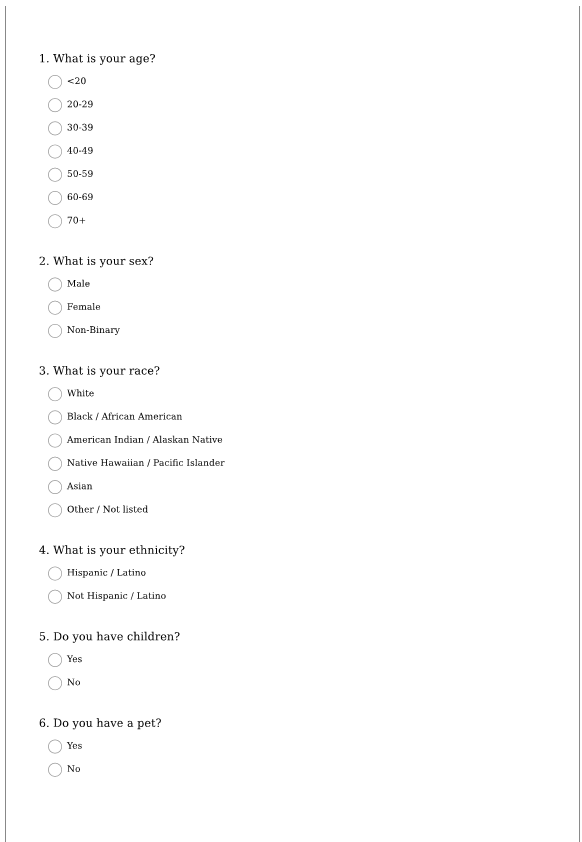
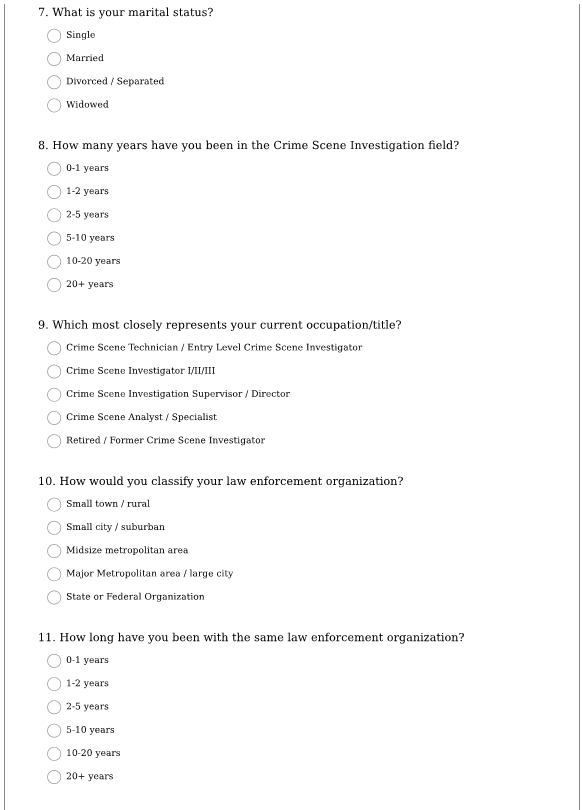

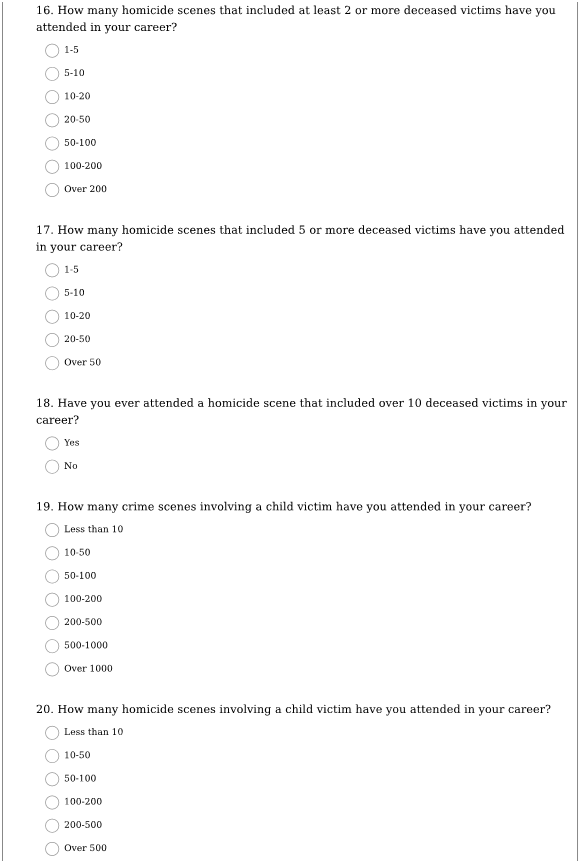
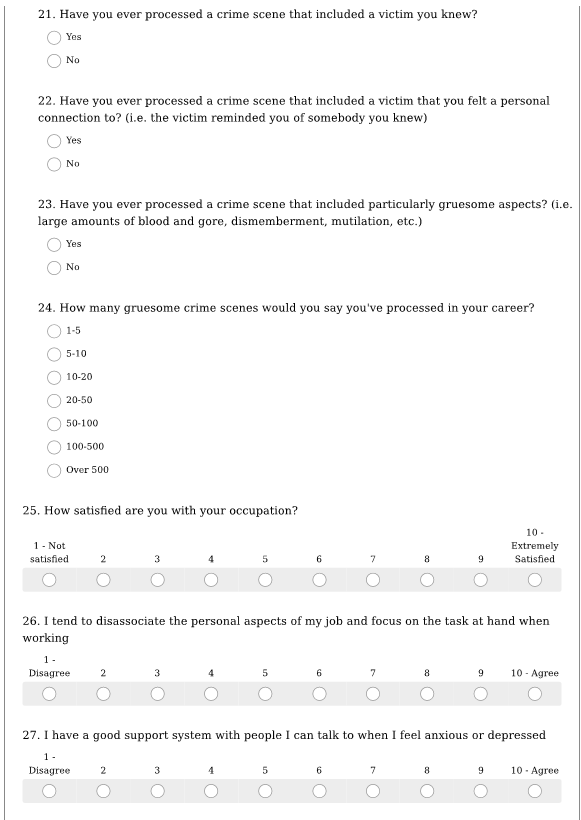
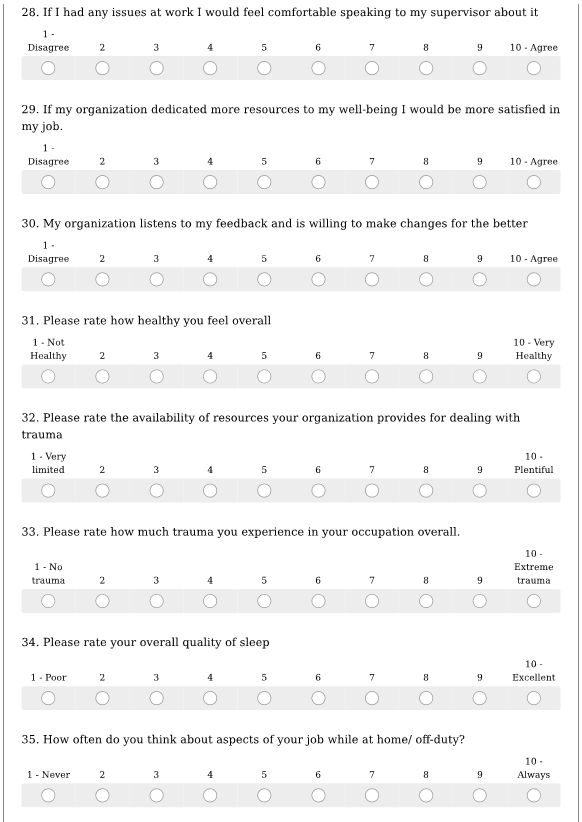
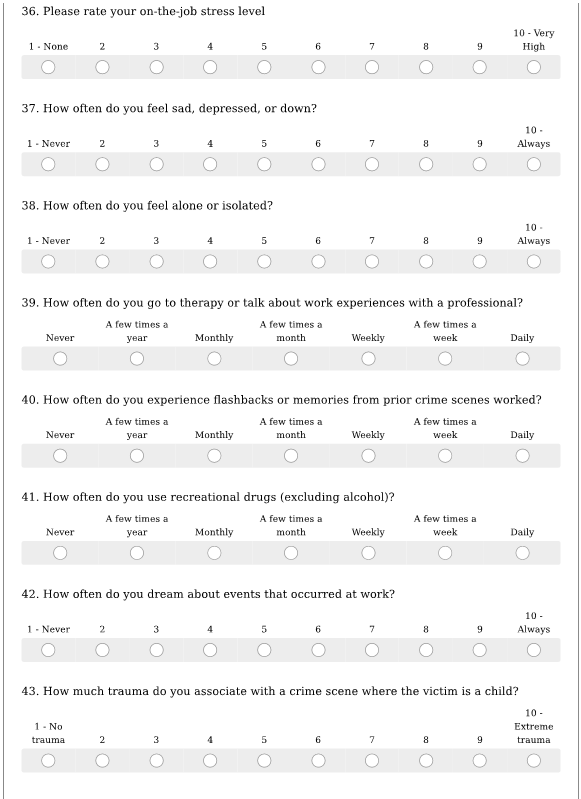
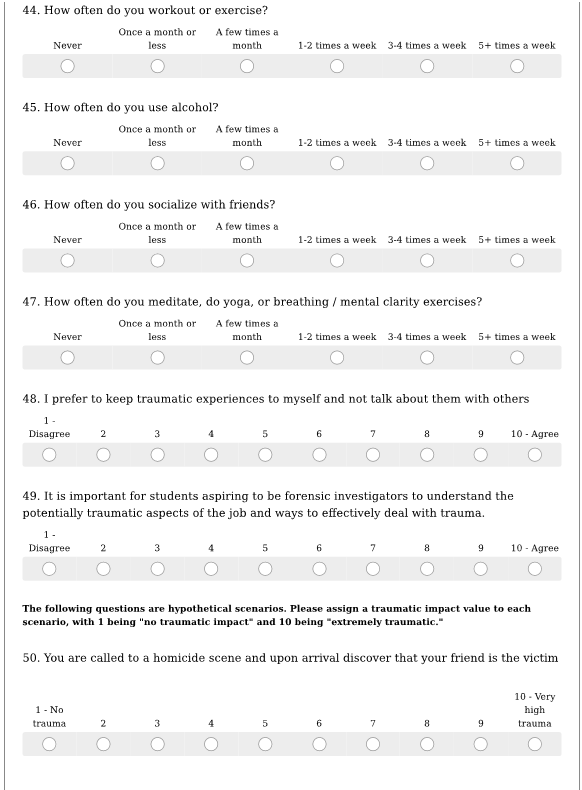
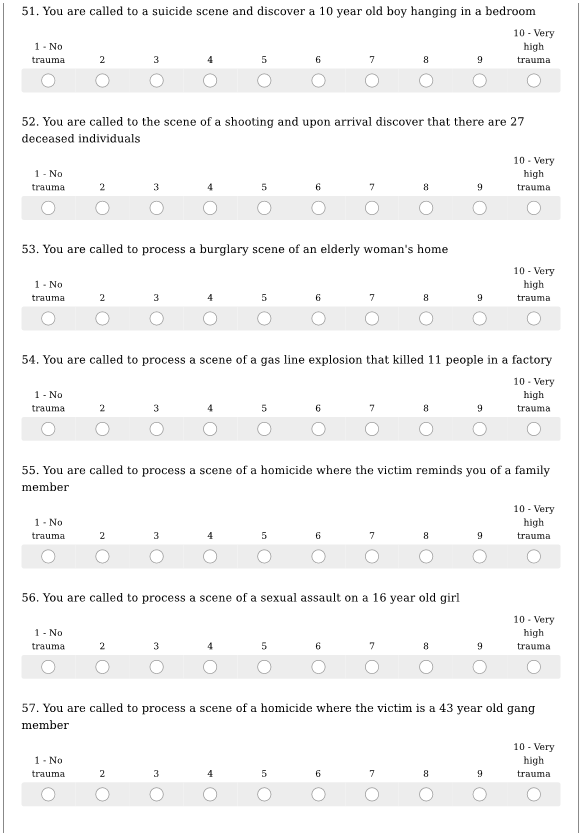

About the Author
Anton Ferraro
Department of Forensic Science, Stevenson University
FSCI 761: Thesis and Presentation
Dr. Jay Tobin
May 5, 2024
DEDICATION
This work is dedicated to Forensic Science Professionals who are exposed to traumatic circumstances in their occupations.
These professionals deserve to be equipped with the tools needed to deal with trauma in the most effective ways to achieve both peak performance and personal happiness.
 The Correlation and Distinguishment of Vicarious Trauma in Crime Scenes and the Psychological Effects it has on Crime Scene Investigators Copyright: © 2024 by Anton Ferraro. Copyright for this article is retained by the author, with publication rights granted to the Crime Scene Investigation Network. This is an Open Access article distributed under the terms of the Creative Commons Attribution-NonCommercial-NoDerivatives 4.0 International License which permits
unrestricted noncommercial use, distribution, and reproduction, provided the original work is
properly cited and not changed in any way. Based on a work at https://www.crime-scene-investigator.net/the-correlation-and-distinguishment-of-vicarious-trauma-in-crime-scenes-and-the-psychological-effects-it-has-on-crime-scene-investigators.html.
The Correlation and Distinguishment of Vicarious Trauma in Crime Scenes and the Psychological Effects it has on Crime Scene Investigators Copyright: © 2024 by Anton Ferraro. Copyright for this article is retained by the author, with publication rights granted to the Crime Scene Investigation Network. This is an Open Access article distributed under the terms of the Creative Commons Attribution-NonCommercial-NoDerivatives 4.0 International License which permits
unrestricted noncommercial use, distribution, and reproduction, provided the original work is
properly cited and not changed in any way. Based on a work at https://www.crime-scene-investigator.net/the-correlation-and-distinguishment-of-vicarious-trauma-in-crime-scenes-and-the-psychological-effects-it-has-on-crime-scene-investigators.html.
Article submitted by the author. The Crime Scene Investigator Network gratefully acknowledges the author for allowing us to reproduce the article .
Article posted May 13, 2024

